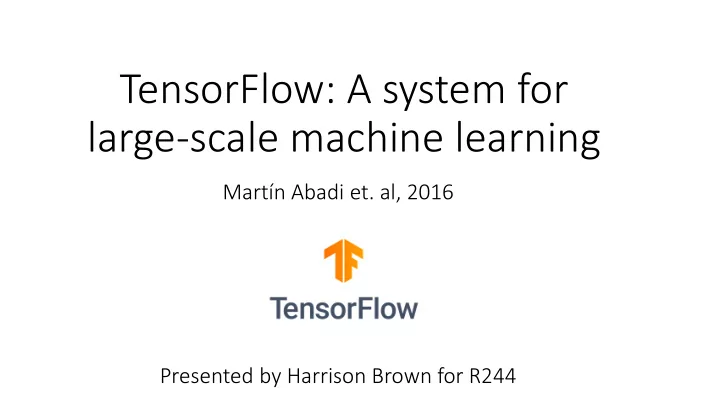

TensorFlow: A system for large-scale machine learning Martín Abadi et. al, 2016 Presented by Harrison Brown for R244
Background • Originally built by Google engineers as successor to proprietary system for distributed training called DistBelief • DistBelief paper published, code not released • DistBelief uses parameter server architecture • Stateless workers, stateful parameter servers • Machine learning algorithms • DAG that terminates with a loss function, backpropagation, SGD • TensorFlow used internally at Google before being released as open source • Dataflow architecture
4 Extensions • New layers • DistBelief uses C++, limits ability for researchers to experiment • Refining training Algorithms • SGD can be optimized in several ways (Adam, AdaGrad, etc) • DistBelief requires modifications of parameter server implementation • New training algorithms • Need system that works well for other ML algorithms besides feed-forward NNs (ex. Adversarial networks, reinforcement learning, expectation- maximization etc) • Ease of prototyping on local machines, GPU acceleration
https://www.tensorflow.or g/tensorboard/r1/graphs
Comparison • Torch • Imperative model, control over execution and performance • Lack of dataflow graph hurts experimentation, training, and ease of deployment • Caffe • Easy to create new models with existing layers, but difficult for research into new models or optimizers, not extensible • Focus on CNNs (at time of paper) difficult to use RNNs • Theano • Computation graph, mathematical operations, control flow and loops. Flexible • Difficult to scale • MXNet • Computation graph, runs and scales very efficiently
Technical Design • High-level scripting interface, ease of use, research oriented • Individual mathematical operators are nodes in dataflow • Easier to compose novel layers • Two phases • Define program as symbolic graph • Execute optimized version on available devices • Common abstraction for accelerators • Operations on Tensors • Tasks (PS tasks and worker tasks)
Execution • Single dataflow graph • Supports multiple concurrent executions on overlapping subgraphs • Vertices (Operations) with mutable state • Permits in place updates • Takes in m tensors as input, n tensors as output • Tensors • N-dimensional arrays with small number of primitive types • Can support asynchronous and synchronized execution • Lock free SGD is most common • Allows operations to be manually placed • Automatic differentiation of control flow constructs
Implementation • C++ implementation for performance, can run on standard architectures • Master obtains subgraphs for each device • Executor handles requests from the master • Tooling support (graph visualization, profiler for traces, etc)
Evaluation examples • Designed to be fast, not the fastest • MxNet comparison on image classification • Demonstrate the scalability
Impact • One of the most popular systems for machine learning • Adopted very quickly • Used widely in industry and in research • Built for machine learning, but general enough for other computations • The original TensorFlow is high-quality software, built to be extensible • Over 60,000 commits and ~2.4 million lines of code today • TensorFlow (arguably) killed Theano as it is nearly a complete replacement
Issues • Static dataflow graphs places limitations on some algorithms such as deep reinforcement learning • The Ray project attempts to address some of these issues • Fault tolerance doesn't account for strong consistency potentially needed by some algorithms • Note, the overhead required has a drastic change in performance • Stated MxNet performance nearly identical in this paper, however that may not be the case
Questions?
Sources • [1] M. Abadi et al. Tensorflow: A system for large-scale machine learning. OSDI, 2016. • [2] M. Abadi, M. Isard and D. Murray: A Computational Model for TensorFlow - An Introduction, MAPL, 2017 • [3] Team, The Theano Development, et al. Theano: A Python framework for fast computation of mathematical expressions. arXiv preprint arXiv:1605.02688, 2016. • [4] TensorFlow, 2019. www.tensorflow.org
Recommend
More recommend